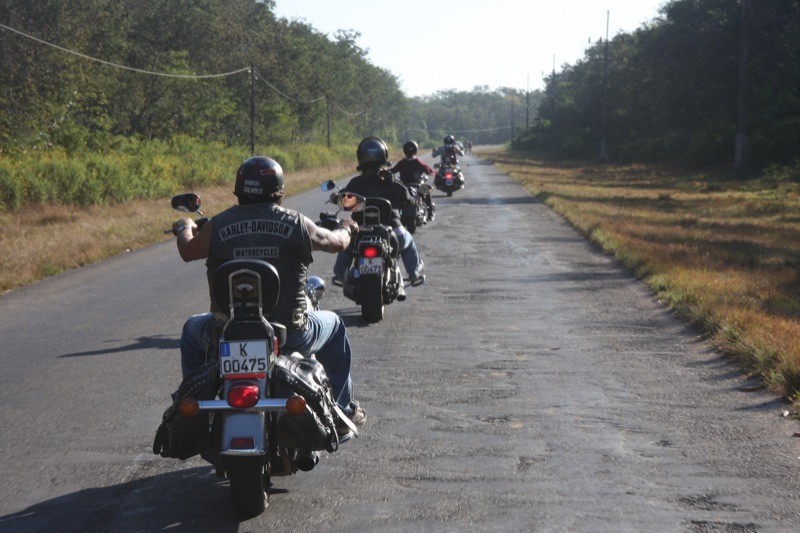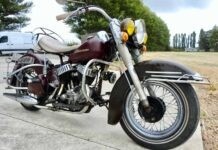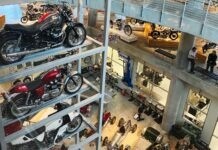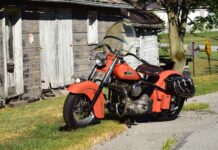In preparation for our trip to Cuba in early 2017, I had read extensively about the country. What I discovered is that there is no way to prepare for the cultural, sensory, or visual experience that is the essence of Cuba. We were so fortunate to have Luis Enrique as our tour guide. He lives and breathes not only his native Cuba but the Harley-Davidson lifestyle. As a former president of the Classic Motorbike Club, he was the perfect host to guide us through the nooks and crannies of the biker world that permeates the underground of Cuba. Our state guide was Alex, who administered all the tour details with restaurants, hotels and museums. Jorge was our affable driver and a dead ringer for Denzel Washington.
As we descended into the Havana airport the excitement in our group was building. We each had our own concept of what it would be like and all of us were wrong. The airport experience was much better than I anticipated and came off as orderly and as efficient as it could be doing everything manually; even the moving of luggage is done with many hands. No conveyors here! We were met by our hosts at the airport entrance and began our descent into the Cuban lifestyle. Sensory overload is immediate as the whirl of old cars and trucks surrounds you. Everywhere you look tells you there is a “B” movie being shot and you are part of the set. The path to our hotel was long and winding through the streets of Havana. The bus was quiet as we tried to process what was going on around us.

Upon arrival at the NH Panorama Hotel we were greeted with a massive glass structure that has become known as the Glass Cathedral. It is very modern with high ceilings, marble and state-of-the-art high-speed elevators. Multiple bars, restaurants and relaxing venues were a stark contrast to our winding journey to get there.


After relaxing and getting settled into our rooms we headed out to a private restaurant for dinner. Our bus wound through neighborhoods and dark streets before finally stopping in front of a nondescript building that turned out to be a magnificently appointed dining venue.
The owner is a very engaging young fellow who obviously comes from money and is opening his second high-end restaurant soon. We had a fabulous meal that ended a long but wonderful day.
The next day we geared up and headed out to pick up our bikes. Neatly lined up in an underground garage were eight relatively modern Harleys, mostly 10- to 15-year-old Heritage Softails and one Road King. Once everyone picked out a bike and got comfortable with it, we headed out with Luis for a tour of Havana. It was truly baptism by fire. If you have never ridden in a third-world country, there is no way to prepare for the experience. Cars, trucks, buses, motorbikes, bicycles, pedestrians, horses, and every other mode of transportation imaginable comes at you from every direction. It can be very disconcerting and create safety issues very quickly.
A highlight of Havana is the Ernest Hemingway compound which he bought in 1940 and lived in continuously until 1960 when he left it to the Cuban people as a museum. We rang the bell at the front entry, looked in every room (from the outside) at how he lived, and saw the pool where Ava Gardner swam naked, the pet cemetery and the boat named after his girlfriend Pilar.

On the following day we headed out of Havana for the small town of Playa Larga. We were all thrilled to get out of the hustle and bustle of Havana. The ride was a lazy run down mostly four-lane roads. It was nice to just let the wind blow by and not worry about traffic. We lunched in a small town called Australia, a fairly popular tourist area and the site of the only gambling left in Cuba. Very few people know that Havana was a huge gambling and mob Mecca from prohibition to the Castro revolution in 1959 when Castro shut down all mob activity, directly resulting in the growth of gambling in Las Vegas! But here in Australia, the game of chance that we tried involved a guinea pig, a wheel, and 16 little houses. You bet on which house the guinea pig will enter after he has been spun around on the wheel several times. Marilyn and I gambled and she won, but I felt sorry for the pig as he must surely have been dizzy.
Playa Larga is a sleepy little one-street town on the north end of Bahia de Cochinos (Bay of Pigs). We rolled into town to a rock star greeting which we soon realized was the norm during our travels. Fists and raised salutes were everywhere we went. We stayed near the beach in a casa particular (bed and breakfast), and the veranda on my unit was right on the bay. A beer, a cigar, and a slight breeze made for a wonderful end to the day. This beach is one of two invaded by U.S.-backed exiles on April 17,1961. Those of us with ample gray in our hair remember the Bay of Pigs ordeal as a very unsettling time for our country as well as the newly-elected President John F. Kennedy. It marked the beginning of the Cold War. We would find out the next day at the Bay of Pigs Museum in Playa Giron that we were considered Yankee imperialists. The museum outlines in great detail the “tactical genius” of the Cuban forces as they battled foreign forces and achieved a great victory.

And then we were off to Trinidad. This was a long day of riding marked by our arrival after dark. Do not ride in Cuba after dark! All the same hazards are there—potholes, railroad tracks, pedestrians, and cars, bicycles, and horse-and-buggy rigs without lights—but you can’t see them. Our problem arose when we decided to watch the sunset from a beach outside of town. It was a beautiful sight but made for a harrowing end to the day.

In this town well known to be stuck in the 1850s, we stayed in another casa particular. Trinidad is truly an amazing place, with bread delivery bicycles carrying huge cardboard boxes for containers, horses’ hooves clattering on cobbled streets, mannequin models in the central square, pigs roasting over an open fire at the bar, and bustling shopping areas on streets constructed in the 1500s. The town was built by the massive fortunes of the sugar industry, and we saw opulent Spanish mansions with European decor, huge, ornate Catholic churches and everywhere people scurrying to places unknown to us. We toured the Museo de Historia Municipal which is a mansion built and owned by generations of the Borrell family, and then bought by the Cantero family. It is still called the Palacia Cantero today. The mansion is a testimony to the massive fortunes available to appoint these houses with items from around the globe.
Following our visit to Trinidad, the trip to Camaguey was a short and a very enjoyable ride. As we stopped for fuel and then to rest in small town squares we were inundated with folks wanting to see the bikes as well as the riders. We had two female riders, Karen Erby and Sue Super, which is a very unusual sight in Cuba. In fact it might be safe to say that none of the folks we met had ever seen a women rider. Camaguey is a very unusual town. It was founded in 1514 and moved several times until landing in its present location in 1528. The streets were laid out in a dizzying maze of angles and winding alleyways in order to confuse the pillaging pirates who often tried to steal and molest the local populace. By making their streets a maze they had ample time to defend themselves and if necessary flee the marauding hordes. The streets are so narrow and confusing we hired bike taxis to take us around the city. There is no way to navigate if you do not use this mode of transportation since there are no street signs or road signs.
We met Luis’ wife and one of his Cuban Harlista buddies who joined us for lunch and dinner.

In fact, throughout the trip we had been most fortunate to engage Luis and Alex in a multitude of discussions regarding education, work incentives, government oversight, Cuban pride, and the general outlook for the future of Cuba. These are discussions I doubt most visitors get to engage in but we spent so much time with our folks they became very comfortable and honest with us. We are also a very inquisitive group. Cuban people are undeniably proud and will defend their way of life and culture to the max. Many of them have never left the island and have little access to the Internet and social media. As such they are products of the Cuban education system and history. Luis is fortunate to have traveled extensively to Europe and has access to many outside sources of news, yet he is still fiercely loyal to Cuba and in fact chose to stay there as his family moved to Miami. He has created a wonderful life for himself and his family but looks upon the political arena in the U.S. with concern and trepidation. While we were there the “wet foot, dry foot” policy, where anyone who fled Cuba and entered the U.S. was allowed to pursue residency a year later, was rescinded and this was of great concern to the Cuban people.
Currently the government is loosening the reins on its people and allowing private restaurants as well as the casas particulares to operate, which allows regular folks to earn extra money. Each Cuban is guaranteed 30 CUCs (Cuban Convertible Pesos) per month, which is pegged to the U.S. dollar. Cubans also have a place to live, free healthcare, free education to any level, any time they want it. They receive a ration book for sugar, beans, rice, and meat each month. Having said that when we went into a grocery store the shelves were mostly bare. There was only one choice for sugar, beans, and rice, and there was no fresh meat or vegetables. Amenities come from the black market. As time moves forward the culture of Cuba will most definitely change. Internet will supply world news, views, and social media, and it is believed that capitalism will become an accepted norm as people experience the newfound rise in their standard of living.

We will continue our journey next month as we circle around the north coast and immerse ourselves in Che Guevara’s victory in his hometown of Santa Clara.



















[…] Read Touring Cuba: Part 1 here. […]